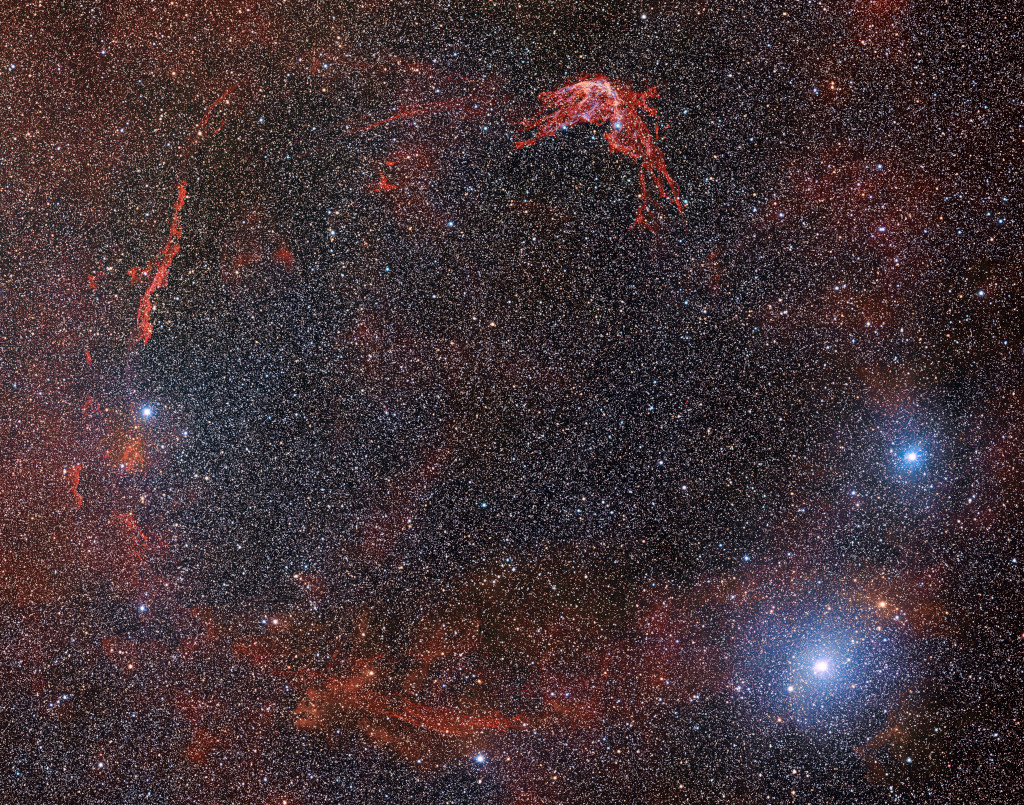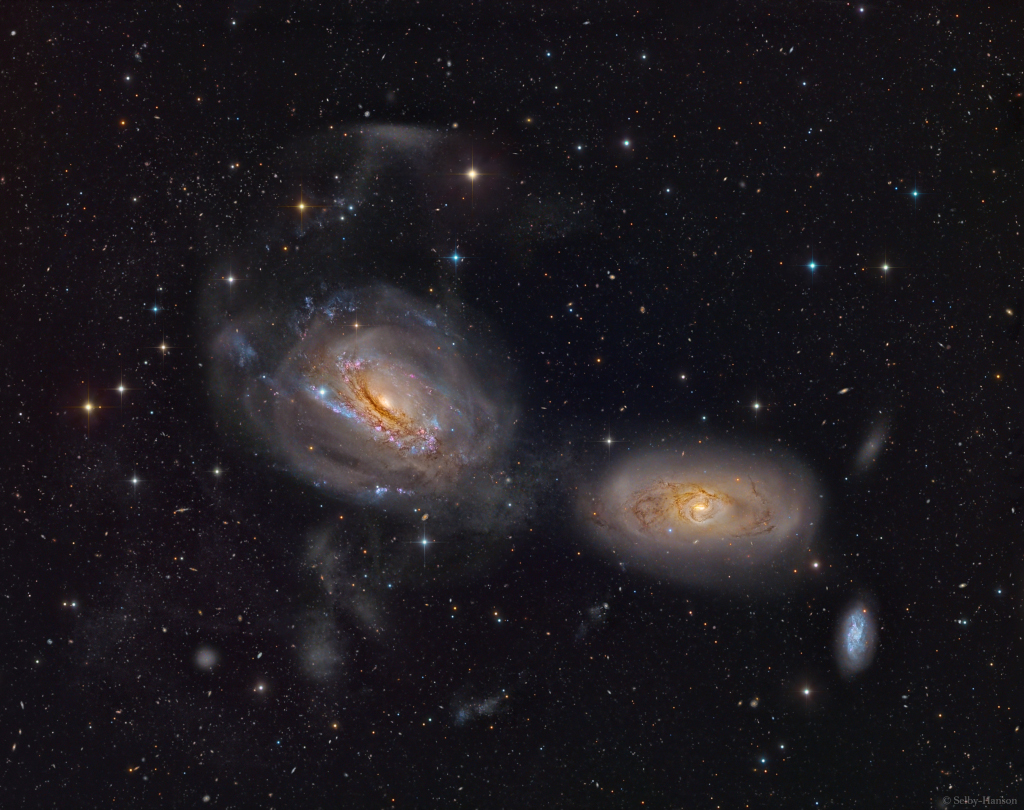Blog
Chandra X-ray Observatory teamed up with the Webb telescope to create a new stunning composite image of the Tarantula Nebula. Chandra’s X-rays (shown in royal blue and purple) identify extremely hot gas and supernova explosion remnants, while Webb reveals forming baby stars.
Unlike most nebulas in our Milky Way, the Tarantula Nebula has a chemical composition similar to that of conditions in our galaxy several billion years ago — when star formation was at its peak. For astronomers, this nebula is the perfect window into how stars formed in our galaxy in the distant past.

Jan Garbarek (born 4 March 1947) is a Norwegian jazzsaxophonist, who is also active in classical music and world music.
Garbarek was born in Mysen, Østfold, southeastern Norway, the only child of a former Polish prisoner of war, Czesław Garbarek, and a Norwegian farmer’s daughter. He grew up in Oslo, stateless until the age of seven, as there was no automatic grant of citizenship in Norway at the time. When he was 21, he married the author Vigdis Garbarek. He is the father of musician and composer Anja Garbarek.
more...Antonio Lucio Vivaldi (4 March 1678 – 28 July 1741) was a Venetian composer, virtuoso violinist and impresario of Baroque music. Along with Johann Sebastian Bach and Georg Frideric Handel, Vivaldi is regarded as one of the greatest Baroque composers and his influence during his lifetime was widespread across Europe, giving origin to many imitators and admirers. He pioneered many developments in orchestration, violin technique and programmatic music. He consolidated the emerging concerto form into a widely accepted and followed idiom, which was paramount in the development of Johann Sebastian Bach‘s instrumental music.
Vivaldi composed many instrumental concertos, for the violin and a variety of other musical instruments, as well as sacred choral works and more than fifty operas. His best-known work is a series of violin concertosknown as the Four Seasons. Many of his compositions were written for the all-female music ensemble of the Ospedale della Pietà, a home for abandoned children. Vivaldi began studying for the priesthood at the age of 15 and was ordained at 25, but was given dispensation to no longer say public Masses due to a health problem. Vivaldi also had some success with expensive stagings of his operas in Venice, Mantua and Vienna. After meeting the Emperor Charles VI, Vivaldi moved to Vienna, hoping for royal support. However, the Emperor died soon after Vivaldi’s arrival, and Vivaldi himself died in poverty less than a year later.
After almost two centuries of decline, Vivaldi’s musical reputation underwent a revival in the early 20th century, with much scholarly research devoted to his work. Many of Vivaldi’s compositions, once thought lost, have been rediscovered – in one case as recently as 2006. His music remains widely popular in the present day and is regularly played all over the world.
more...Willie Johnson (March 4, 1923 – February 26, 1995) was an American electric blues guitarist. He is best known as the principal guitarist in Howlin’ Wolf‘s band from 1948 to 1953. His raucous, distorted guitar playing is prominent on Howlin’ Wolf’s Memphis recordings during 1951–1953, including the hit song “How Many More Years” (recorded May 1951).
In 2017, Johnson was posthumously inducted in to the Blues Hall of Fame.
Willie Lee Johnson was born in Senatobia, Mississippi. As the guitarist in the first band led by Howlin’ Wolf, he appeared on most of Wolf’s recordings between 1951 and 1953. He provided the slightly jazzy yet raucous guitar sound that was the signature of all of Wolf’s Memphis recordings. Johnson also performed and recorded with other blues artists in the Memphis area, including pianist Willie Love, Willie Nix, Junior Parker, Roscoe Gordon, Bobby “Blue” Bland and others
more...Zenzile Miriam Makeba (4 March 1932 – 9 November 2008), nicknamed Mama Africa, was a South African singer, songwriter, actress, and civil rights activist. Associated with musical genres including Afropop, jazz, and world music, she was an advocate against apartheid and white-minority government in South Africa.
Born in Johannesburg to Swazi and Xhosa parents, Makeba was forced to find employment as a child after the death of her father. She had a brief and allegedly abusive first marriage at the age of 17, gave birth to her only child in 1950, and survived breast cancer. Her vocal talent had been recognized when she was a child, and she began singing professionally in the 1950s, with the Cuban Brothers, the Manhattan Brothers, and an all-woman group, the Skylarks, performing a mixture of jazz, traditional African melodies, and Western popular music. In 1959, Makeba had a brief role in the anti-apartheid film Come Back, Africa, which brought her international attention, and led to her performing in Venice, London, and New York City. In London, she met the American singer Harry Belafonte, who became a mentor and colleague. She moved to New York City, where she became immediately popular, and recorded her first solo album in 1960. Her attempt to return to South Africa that year for her mother’s funeral was prevented by the country’s government.
Makeba’s career flourished in the United States, and she released several albums and songs, her most popular being “Pata Pata” (1967). Along with Belafonte, she received a Grammy Award for Best Folk Recording for her 1965 album An Evening with Belafonte/Makeba. She testified against the South African government at the United Nations and became involved in the civil rights movement. She married Stokely Carmichael, a leader of the Black Panther Party, in 1968. As a result, she lost support among white Americans. Her visa was revoked by the US government when she was traveling abroad, forcing her and Carmichael to relocate to Guinea. She continued to perform, mostly in African countries, including at several independence celebrations. She began to write and perform music more explicitly critical of apartheid; the 1977 song “Soweto Blues“, written by her former husband Hugh Masekela, was about the Soweto uprising. After apartheid was dismantled in 1990, Makeba returned to South Africa. She continued recording and performing, including a 1991 album with Nina Simone and Dizzy Gillespie, and appeared in the 1992 film Sarafina!. She was named an FAO Goodwill Ambassador in 1999, and campaigned for humanitarian causes. She died of a heart attack during a 2008 concert in Italy.
Makeba was among the first African musicians to receive worldwide recognition. She brought African music to a Western audience, and popularized the world music and Afropop genres. She also made popular several songs critical of apartheid, and became a symbol of opposition to the system, particularly after her right to return was revoked. Upon her death, former South African President Nelson Mandela said that “her music inspired a powerful sense of hope in all of us.”
more...Wayne Shorter, the enigmatic, intrepid saxophonist who shaped the color and contour of modern jazz as one of its most intensely admired composers, died on Thursday March 2nd 2023 in Los Angeles. He was 89.
His publicist, Alisse Kingsley, confirmed his death, at a hospital. There was no immediate information on the cause.
Mr. Shorter had a sly, confiding style on the tenor saxophone, instantly identifiable by his low-gloss tone and elliptical sense of phrase. His sound was brighter on soprano, an instrument on which he left an incalculable influence; he could be inquisitive, teasing or elusive, but always with a pinpoint intonation and clarity of attack.
His career reached across more than half a century, largely inextricable from jazz’s complex evolution during that span. He emerged in the 1960s as a tenor saxophonist and in-house composer for pace-setting editions of Art Blakey’s Jazz Messengers and the Miles Davis Quintet, two of the most celebrated small groups in jazz history.
more...In 185 AD, Chinese astronomers recorded the appearance of a new star in the Nanmen asterism. That part of the sky is identified with Alpha and Beta Centauri on modern star charts. The new star was visible to the naked-eye for months, and is now thought to be the earliest recorded supernova. This deep telescopic view reveals the wispy outlines of emission nebula RCW 86, just visible against the starry background,understood to be the remnant of that stellar explosion. Captured by the wide-field Dark Energy Camera operating at Cerro Tololo Inter-American Observatory in Chile, the image traces the full extent of a ragged shell of gas ionized by the still expanding shock wave. Space-based images indicate an abundance of the element iron in RCW 86 and the absence of a neutron star or pulsar within the remnant, suggesting that the original supernova was Type Ia. Unlike the core collapse supernova explosion of a massive star, a Type Ia supernova is a thermonuclear detonation on a white dwarf star that accretes material from a companion in a binary star system. Near the plane of our Milky Way galaxy and larger than the full moon on the sky this supernova remnant is too faint to be seen by eye though. RCW 86 is some 8,000 light-years distant and around 100 light-years across.

Willie Chambers (born March 3, 1938) is a singer, guitarist, and former member of The Chambers Brothers, a rock band in the 1960s with hits “In The Midnight Hour“, “I Can’t Turn You Loose“, and “Time Has Come Today“. He continues to be a regular attraction at various venues in Los Angeles and further afield.
Along with brothers Lester, Joe and George, Willie was a founding member of The Chambers Brothers and stayed with them through their evolution which included the addition of drummer Brian Keenan in 1965 and the group’s eventual breakup. He sang lead on one of their hits, a cover of Wilson Pickett‘s “In The Midnight Hour“. He also co-wrote their biggest hit “Time Has Come Today” with his brother Joe. He would later work as a session musician. More recently, he has become more active and has collaborated with artists such as Louis Metoyer. He has also been involved with Australian born artists such as Jessie Sparks and singer Stephen Rowe, appearing in his “Restless Soul” video.
more...Robyn Rowan Hitchcock (born 3 March 1953) is an English singer-songwriter and guitarist. While primarily a vocalist and guitarist, he also plays harmonica, piano, and bass guitar. After leading the Soft Boys in the late 1970s and releasing the influential Underwater Moonlight, Hitchcock launched a prolific solo career. His musical and lyrical styles have been influenced by Bob Dylan, John Lennon, Syd Barrett, Captain Beefheart, Martin Carthy, Lou Reed, Roger McGuinn and Bryan Ferry.
more...James Emory Garrison (March 3, 1934 – April 7, 1976) was an American jazz double bassist. He is best remembered for his association with John Coltrane from 1961 to 1967.
Garrison was born in Miami, Florida and moved to Philadelphia when he was 10, where he learned to play bass during his senior year of high school. Garrison came of age in the 1950s Philadelphia jazz scene, which included fellow bassists Reggie Workman and Henry Grimes, pianist McCoy Tyner and trumpeter Lee Morgan. Between 1957 and 1962, Garrison played and recorded with trumpeter Kenny Dorham; clarinetist Tony Scott; drummer Philly Joe Jones; and saxophonists Bill Barron, Lee Konitz, and Jackie McLean, as well as Curtis Fuller, Benny Golson, Lennie Tristano, and Pharoah Sanders, among others. In 1961, he recorded with Ornette Coleman, appearing on Coleman’s albums Ornette on Tenor and The Art of the Improvisers. He also worked with Walter Bishop, Jr. and Cal Massey during the early years of his career. Jimmy Garrison died of lung cancer on April 7, 1976.
more...Arthel Lane “Doc” Watson (March 3, 1923 – May 29, 2012) was an American guitarist, songwriter, and singer of bluegrass, folk, country, blues, and gospel music. Watson won seven Grammy awards as well as a Grammy Lifetime Achievement Award. Watson’s fingerstyle and flatpicking skills, as well as his knowledge of traditional American music, were highly regarded. Blind from a young age, he performed publicly both in a dance band and solo, as well as for over 15 years with his son, guitarist Merle Watson, until Merle’s death in 1985 in an accident on the family farm.
Watson was born in Deep Gap, North Carolina. According to Watson on his three-CD biographical recording Legacy, he got the nickname “Doc” during a live radio broadcast when the announcer remarked that his given name Arthel was odd and he needed an easy nickname. A fan in the crowd shouted “Call him Doc!”, presumably in reference to the literary character Sherlock Holmes‘s companion, Doctor Watson. The name stuck.
more...
“Taranto” is a flamenco style whose origin is in Almería. It derives from the “taranta”, but it follows a rhythm. That makes possible to dance it, in the same way as “zambra mora”. “Taranto” comes from the mining area of Almeria. First singer this style was Pedro Morato but it’s important to quote “El Cabogatero” (1810-1880) and “El Ciego de la Playa” (born around 1840). We must also mention Juan Diaz Abad “Chilares”, born in 1868 in Zapillo, Almeria. “Taranto” is included in “cantes mineros” (fandango, taranto and taranta) and was developed in Almeria, in flamenco evenings, between the 19th and 20th centuries, in three cafes: “Frailito” (Plaza de Santo Domingo), “España” (C/Sebastián Perez, today General Rada), and “Lyon de Oro”.
Flamenco club “El Taranto” is responsible for maintaining this tradition. Regarding the dance, Carmen Amaya is considered as the mother of “Taranto”. “Taranto” was also related to styles of the region of Murcia, whose link was mining lifestyle and singers as El Morato and Chilares, who lived in Cartagena and Almeria. Rojo el Alpargatero lived in Almeria most of his life. There were also influences with Jaén, Linares and La Carolina. The “taranteros” and miners were together with the most famous singers from Jaen such as Basilio, Los Heredia, el Bacalao, Cabrerillo, el Tonto Linares. The bond was the mining railway between Linares and Almeria. There were quite flamenco’s influences between Almería and Málaga. In 1881, the great singer La Rubia de Málaga was hired by the Almería casino. Her stay there would explain that the singing of “El Ciego de la Playa” influenced to the malagueña of “El Canario”, lover of La Rubia de Málaga. It was also learned by Antonio Chacón when he went to Almería to know its flamenco singings.
more...
Spiral galaxy NGC 3169 looks to be unraveling like a ball of cosmic yarn. It lies some 70 million light-years away, south of bright star Regulus toward the faint constellation Sextans. Wound up spiral arms are pulled out into sweeping tidal tails as NGC 3169 (left) and neighboring NGC 3166 interact gravitationally. Eventually the galaxies will merge into one, a common fate even for bright galaxies in the local universe. Drawn out stellar arcs and plumes are clear indications of the ongoing gravitational interactions across the deep and colorful galaxy group photo. The telescopic frame spans about 20 arc minutes or about 400,000 light-years at the group’s estimated distance, and includes smaller, bluish NGC 3165 at the right. NGC 3169 is also known to shine across the spectrum from radio to X-rays, harboring an active galactic nucleus that is the site of a supermassive black hole.

Lewis Allan Reed (March 2, 1942 – October 27, 2013) was an American musician, songwriter, and poet. He was the guitarist, singer, and principal songwriter for the rock band the Velvet Undergroundand had a solo career that spanned five decades. Although not commercially successful during its existence, the Velvet Underground became regarded as one of the most influential bands in the history of underground and alternative rock music. Reed’s distinctive deadpan voice, poetic and transgressive lyrics, and experimental guitar playing were trademarks throughout his long career.
Having played guitar and sung in doo-wop groups in high school, Reed studied poetry at Syracuse University under Delmore Schwartz, and had served as a radio DJ, hosting a late-night avant garde music program while at college. After graduating from Syracuse, he went to work for Pickwick Recordsin New York City, a low-budget record company that specialized in sound-alike recordings, as a songwriter and session musician. A fellow session player at Pickwick was John Cale; together with Sterling Morrison and Angus MacLise, they would form the Velvet Underground in 1965. After building a reputation on the avant garde music scene, they gained the attention of Andy Warhol, who became the band’s manager; they in turn became something of a fixture at The Factory, Warhol’s art studio, and served as his “house band” for various projects. The band released their first album, now with drummer Moe Tucker and featuring German singer Nico, in 1967, and parted ways with Warhol shortly thereafter. Following several lineup changes and three more little-heard albums, Reed quit the band in 1970.
more...Larry Eugene Carlton (born March 2, 1948) is an American guitarist who built his career as a studio musician in the 1970s and 1980s for acts such as Steely Dan and Joni Mitchell. He has participated in thousands of recording sessions, recorded on hundreds of albums in many genres, including more than 100 gold records, as well as for television and movies. He has been a member of the jazz fusion group the Crusaders, the smooth jazz band Fourplay, and has maintained a long solo career.
Carlton was born in Torrance, California, United States, and at the age of six began guitar lessons. His interest in jazz came from hearing guitarist Joe Pass on the radio, after which he moved on to jazz guitarists Barney Kessel and Wes Montgomery, and blues guitarist B.B. King. He went to junior college and Long Beach State College while playing professionally at clubs in Los Angeles.
more...Edward F. Davis (March 2, 1922 – November 3, 1986), known professionally as Eddie “Lockjaw” Davis, was an American jazz tenor saxophonist. It is unclear how he acquired the moniker “Lockjaw” (later shortened in “Jaws”): it is either said that it came from the title of a tune or from his way of biting hard on the saxophone mouthpiece. Other theories have been put forward.
Davis played with Cootie Williams, Lucky Millinder, Andy Kirk, Eddie Bonnemère, Louis Armstrong, and Count Basie, as well as leading his own bands and making many recordings as a leader. He played in the swing, bop, hard bop, Latin jazz, and soul jazz genres. Some of his recordings from the 1940s also could be classified as rhythm and blues.
more...More Posts
- The Cosmos with NGC 3372
- Johnny Guitar Watson Day
- Bobby Durham Day
- Lil Hardin Armstrong Day
- World Music with Kel Assouf
- Daily Roots with Wicked Dub Division & North East Ska Jazz Orchestra
- HAIR the rock musical 2 shows 2-2-19
- Echos of Freedom by Sojourner Truth
- The Cosmos with LDN 1622
- Graham Nash Day
- Stan Getz Day
- Sonny State Day
- World Music with Maracatu by DJ Blue
- Daily Roots with the Four Aces
- HAIR the tribal rock musical 2-1-19
- Echos of Freedom by the Dalai Lama
- The Cosmos with NGC 4567/68/64
- Joshua Redman Day
- Joe Sample Day
- Tricky Sam Nanton